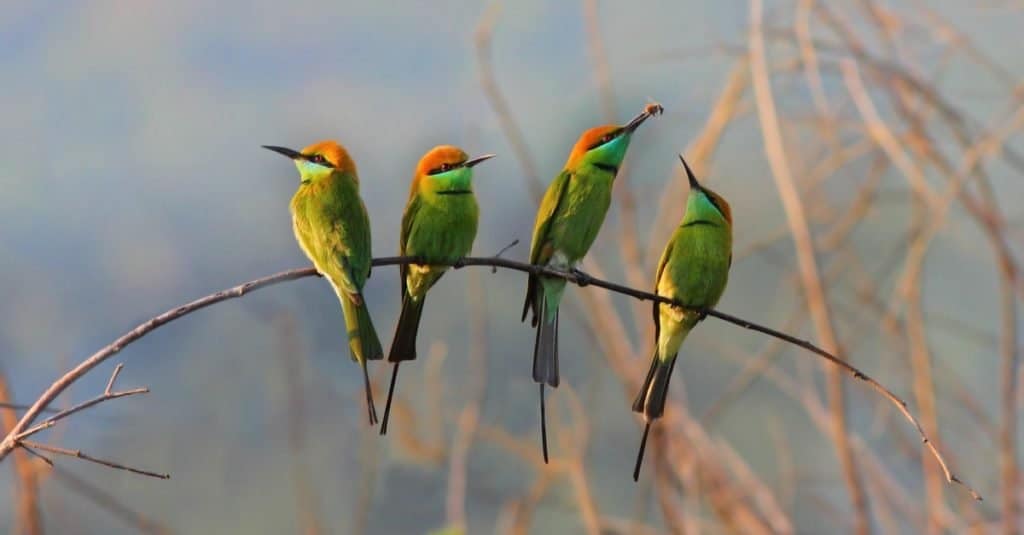Green Bee-Eater
Merops orientalis
80% of its diet consists of honeybees
Advertisement
Green Bee-Eater Scientific Classification
- Kingdom
- Animalia
- Phylum
- Chordata
- Class
- Aves
- Order
- Coraciiformes
- Family
- Meropidae
- Genus
- Merops
- Scientific Name
- Merops orientalis
Read our Complete Guide to Classification of Animals.
Green Bee-Eater Conservation Status
Green Bee-Eater Facts
- Main Prey
- Honeybee, Bees, Flying Insects
- Fun Fact
- 80% of its diet consists of honeybees
- Distinctive Feature
- Long curved beak and bright green plumage
- Wingspan
- 29-49cm (11.4-19.3in)
- Incubation Period
- 14-22 days
- Habitat
- Grasslands and open forests
- Predators
- Eagles, Storks, Raptors
- Diet
- Omnivore
- Lifestyle
- Solitary
- Type
- Bird
- Common Name
- Green Bee-Eater
- Average Clutch Size
- 4
- Slogan
- Mainly eats honeybees!
View all of the Green Bee-Eater images!
The green bee-eater, or little green bee-eater, is one of the smallest birds in the bee-eater family.
It is known for its small size, unique sound, slender body, and bright plumage as well as for being one of the most beautiful birds. It is found in a variety of wooded areas throughout sub-Saharan Africa, western Arabia, and east Asia. Although it’s in no danger of extinction, it is experiencing a decline in its native habitat as well as populations of its main prey, honeybees.
Green Bee-Eater Amazing Facts!
- True to its name, 80% of its diet consists of honeybees.
- Although it is not known to migrate, it does travel seasonally due to rainfall.
- The green bee-eater is a natural-born bee-killer.
- It has predator-avoidance behavior with “theory of mind” awareness usually only found in humans and other primates.
Where To Find Green Bee-Eaters
Green bee-eaters find several habitat types from Mauritania to central China, including the Nile River and the Himalayas. Other countries include Greece, Senegal, Gambia, Egypt, Iran, India, Pakistan, Nepal, Bhutan, Afghanistan, Bangladesh, Cambodia, Thailand, Laos, Myanmar, and Vietnam. Its habitat is forest, grassland, and thin scrub.
The best place to find green bee-eaters is arid areas, plains, savannahs, scrub, grasslands, open forests, fields, and farmlands in parts of Africa and Asia. They can even be seen perched on television antennae in urban and suburban neighborhoods. They are also visitors in some parts of Pakistan, flying there during the summer, making riverside habitats in southern India or high ones in the Himalayas. The social birds roost in numbers from 30 to 300 and usually dust-bathe in groups of 20. Remember that they roost high in trees and have a unique sound.
Green Bee-Eater Nests
Green bee-eaters typically nest in May or June. Their nests are in the hollows of sandbanks or mud banks which both sexes create by digging tunnels or burrows, which are 2-3 feet deep and can be up to 5 feet long (1-2m). The tunnels in Africa are dug into flat ground or gentle slopes, while in Asia they are dug into low shores. The females lay 3-8 eggs on the bare ground at the end of the tunnel, in a cavity measuring about 15cm (5.9in).
Green Bee-Eater Scientific Name
There are 26 subspecies of green bee-eater. Its scientific name is Merops orientalis. The bee-eater family Meropidae has three genera, one of them being the large genus Merops.
Green Bee-Eater Size, Appearance & Behavior
The little green bee-eater has a size of about 9 inches (16-19cm) including 2 inches of long central tail-feathers. It has a wingspan of 29-49cm (11.4-19.3in) and a weight of 15-25g.
Bright emerald green is its main color, but several species have partial red, yellow, blue, or purple coloring depending on the region. There are also variations such as a rusty crown and bright blue throat as well as leucistic individuals. A similar species based on grouping by plumage features is Merops leschenaulti, with subspecies Merops orientalis ferrugeiceps being most similar.
Generally, however, there is blue on the chin and throat, with golden rufous on the crown and back. Its flight feathers are rufous and green. It has a long, slightly curved black bill ending in a sharp point, a narrow black stripe called a “forget” on its throat, a black mask through its crimson eyes and two central, narrow, long black tail streamers. Its legs are dark grey and it has weak feet with three toes.
The juvenile’s colors are dull in comparison. It does not have the long tail-feathers unique to adults. The female has similar coloring and physical measurements as the male but with a duller throat, narrower half-collar and shorter tail streamers.
The green bee-eater sand-bathes more than other bee-eater species and dips in the water while flying. Usually calling in flight, its sound is a gentle, pleasant, nasal tree-tree-tree-tree that is long and repetitive. It is graceful and makes a zig-zag movement when returning to its perch to consume its prey. Most active during the day, it starts hunting after 7:00 or 8:00 am and again around 4:00 pm.

©duangnapa_b/Shutterstock.com
Green Bee-Eater Diet
The green bee-eater has an omnivorous diet that is primarily insectivorous.
What do green bee-eaters eat?
80% of the green bee-eater’s diet is honeybees. The rest is other bee species, wasps, ants, flies, butterflies, moths, dragonflies, beetles, and other flying insects. It supplements its diet with ground-dwelling insects, such as termites, caterpillars, and spiders, along with fruits and berries. It avoids insects from the order Orthoptera which includes grasshoppers, locusts, crickets, katydids, and weta.
Green Bee-Eater Predators and Threats
The green bee-eater has a unique predator-avoidance behavior in which it does not enter its nest as long as a predator is looking at it. This type of awareness of a predator’s mental state shows “theory of mind” typically shared only by primates. Although the IUCN lists the green bee-eater as “Least Concern” it is still vulnerable to native habitat destruction and decline of its primary prey of bees.
What eats green bee-eaters?
Green bee-eaters and their eggs are preyed upon by larger birds as well as smaller reptiles and mammals. They sometimes get gizzard infections from the endoparasitic nematode (Torquatoides balanocephala). In India, they have been known to get a protozoal parasite in their blood (Haemoproteus manwelli).
Green Bee-Eater Reproduction, Babies, and Lifespan
Green bee-eaters have a breeding season from either March to June or July to August.
Although both sexes participate in incubation, it is primarily done by the female. They are monogamous and mate for life. In Africa and Asia, they are solitary nesters with helpers, which include juvenile and adult young. They create small colonies in India, with larger ones in Myanmar and Pakistan ranging from 10-30 breeding pairs. Both parents feed the young, known as chicks, while they stay in the nest for 22-31 days. The juveniles do not need to be taught how to handle stinging insects, as the birds are born with the ability to kill bees. The bird’s lifespan is 12-18 years in the wild.
Green Bee-Eater Population
Green bee-eaters are common in their habitat range and do not migrate. Although their bright plumage and small size attract many larger predators, they display predator-avoidance behavior when seeing predators near their nests. With 26 species, habitats in several countries, and listed as “least concern” by the IUCN, their exact numbers have not been assessed. However, the populations of the African green bee-eater, the Asian green bee-eater, and the Arabian green bee-eater are increasing.
View all 170 animals that start with GGreen Bee-Eater FAQs (Frequently Asked Questions)
Are Green Bee-Eaters herbivores, carnivores, or omnivores?
Green Bee-Eaters are Omnivores, meaning they eat both plants and other animals.
What Kingdom do Green Bee-Eaters belong to?
Green Bee-Eaters belong to the Kingdom Animalia.
What phylum do Green Bee-Eaters belong to?
Green Bee-Eaters belong to the phylum Chordata.
What class do Green Bee-Eaters belong to?
Green Bee-Eaters belong to the class Aves.
What does little green bee-eater eat?
Mostly honeybees, followed by other bee species and other flying insects, then ground-dwelling insects along with fruits and berries.
How big are green bee-eaters?
About 9 inches (16-19cm).
How long do green bee-eaters live?
12-18 years.
Are green bee-eaters really green?
Yes, they are a bright, rich emerald-green color.
What is the scientific name for the green bee-eater?
Merops orientalis.
Does green bee-eater migrate?
No. However, it has been known to travel seasonally due to rainfall.
How many eggs does a green bee-eater lay?
Between 3-8, but 4-5 on average.
How fast does a green bee-eater fly?
26mph (42km).
What is green bee-eater's wingspan?
29-49cm (11.4-19.3in)
When do green bee-eaters leave the nest?
After 22-31 days.
What family do Green Bee-Eaters belong to?
Green Bee-Eaters belong to the family Meropidae.
What order do Green Bee-Eaters belong to?
Green Bee-Eaters belong to the order Coraciiformes.
What type of covering do Green Bee-Eaters have?
Green Bee-Eaters are covered in Feathers.
In what type of habitat do Green Bee-Eaters live?
Green Bee-Eaters live in grasslands and open forests.
What are some predators of Green Bee-Eaters?
Predators of Green Bee-Eaters include eagles, storks, and raptors.
What are some distinguishing features of Green Bee-Eaters?
Green Bee-Eaters have long curved beaks and bright green plumage.
What is the average clutch size of a Green Bee-Eater?
Green Bee-Eaters typically lay 4 eggs.
What is an interesting fact about Green Bee-Eaters?
Green Bee-Eaters mainly eat honeybees!
What is the lifespan of a Green Bee-Eater?
Green Bee-Eaters can live for 12 to 18 years.
How do Green Bee-Eaters have babies?
Green Bee-Eaters lay eggs.
Thank you for reading! Have some feedback for us? Contact the AZ Animals editorial team.
Sources
- eBird, Available here: https://ebird.org/species/grbeat1
- Animalia, Available here: http://animalia.bio/green-bee-eater
- Wikipedia, Available here: https://en.wikipedia.org/wiki/Green_bee-eater
- Nature Conservation, Available here: http://natureconservation.in/green-bee-eater-merops-orientalis-complete-detail-updated/

















